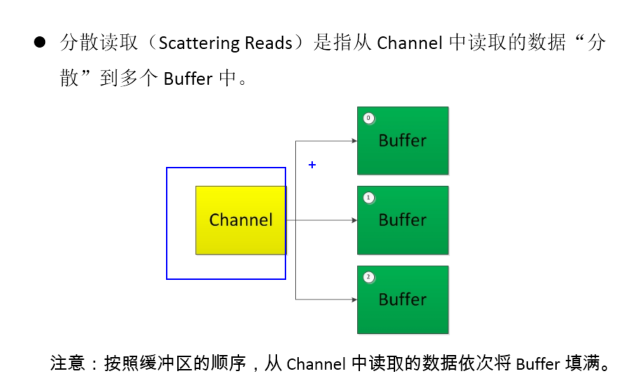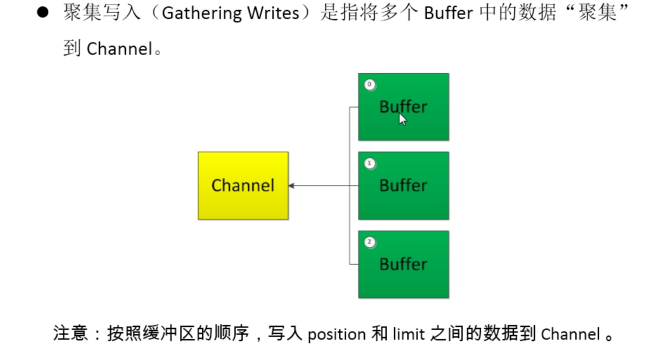一.分散與聚集 1.分散讀取(Scattering Reads):將通道中的數據分散到多個緩衝區中 2.聚集寫入(Gathering Writes):將多個緩衝區中的數據聚集到通道中 二.字元集Charset 三.NIO的非阻塞式(核心:Selector) Selector(選擇器)是Java NI ...
一.分散與聚集
1.分散讀取(Scattering Reads):將通道中的數據分散到多個緩衝區中

2.聚集寫入(Gathering Writes):將多個緩衝區中的數據聚集到通道中

public void test4() throws IOException{
RandomAccessFile raf1 = new RandomAccessFile("1.txt", "rw");
//1. 獲取通道
FileChannel channel1 = raf1.getChannel();
//2. 分配指定大小的緩衝區
ByteBuffer buf1 = ByteBuffer.allocate(100);
ByteBuffer buf2 = ByteBuffer.allocate(1024);
//3. 分散讀取
ByteBuffer[] bufs = {buf1, buf2};
channel1.read(bufs);
//4. 聚集寫入
RandomAccessFile raf2 = new RandomAccessFile("2.txt", "rw");
FileChannel channel2 = raf2.getChannel();
channel2.write(bufs);
}
二.字元集Charset
public void test6() throws IOException{
Charset cs1 = Charset.forName("GBK");
//獲取編碼器
CharsetEncoder ce = cs1.newEncoder();
//獲取解碼器
CharsetDecoder cd = cs1.newDecoder();
CharBuffer cBuf = CharBuffer.allocate(1024);
cBuf.put("字元集!");
cBuf.flip();
//編碼
ByteBuffer bBuf = ce.encode(cBuf);
for (int i = 0; i < 12; i++) {
System.out.println(bBuf.get());
}
//解碼
bBuf.flip();
CharBuffer cBuf2 = cd.decode(bBuf);
System.out.println(cBuf2.toString());
System.out.println("------------------------------------------------------");
Charset cs2 = Charset.forName("UTF-8");
bBuf.flip();
CharBuffer cBuf3 = cs2.decode(bBuf);
System.out.println(cBuf3.toString());
}
三.NIO的非阻塞式(核心:Selector)
Selector(選擇器)是Java NIO中能夠檢測一到多個NIO通道,並能夠知曉通道是否為諸如讀寫事件做好準備的組件。這樣,一個單獨的線程可以管理多個channel,從而管理多個網路連接.
1.TCP
eg:客戶端與服務端
//客戶端
@Test
public void client() throws IOException{
//1. 獲取通道
SocketChannel sChannel = SocketChannel.open(new InetSocketAddress("127.0.0.1", 9898));
//2. 切換非阻塞模式
sChannel.configureBlocking(false);
//3. 分配指定大小的緩衝區
ByteBuffer buf = ByteBuffer.allocate(1024);
//4. 發送數據給服務端
Scanner scan = new Scanner(System.in);
while(scan.hasNext()){
String str = scan.next();
buf.put((new Date().toString() + "\n" + str).getBytes());
buf.flip();
sChannel.write(buf);
buf.clear();
}
//5. 關閉通道
sChannel.close();
}
//服務端
@Test
public void server() throws IOException{
//1. 獲取通道
ServerSocketChannel ssChannel = ServerSocketChannel.open();
//2. 切換非阻塞模式
ssChannel.configureBlocking(false);
//3. 綁定連接
ssChannel.bind(new InetSocketAddress(9898));
//4. 獲取選擇器
Selector selector = Selector.open();
//5. 將通道註冊到選擇器上, 並且指定“監聽接收事件”
ssChannel.register(selector, SelectionKey.OP_ACCEPT);
//6. 輪詢式的獲取選擇器上已經“準備就緒”的事件
while(selector.select() > 0){
//7. 獲取當前選擇器中所有註冊的“選擇鍵(已就緒的監聽事件)”
Iterator<SelectionKey> it = selector.selectedKeys().iterator();
while(it.hasNext()){
//8. 獲取準備“就緒”的是事件
SelectionKey sk = it.next();
//9. 判斷具體是什麼事件準備就緒
if(sk.isAcceptable()){
//10. 若“接收就緒”,獲取客戶端連接
SocketChannel sChannel = ssChannel.accept();
//11. 切換非阻塞模式
sChannel.configureBlocking(false);
//12. 將該通道註冊到選擇器上
sChannel.register(selector, SelectionKey.OP_READ);
}else if(sk.isReadable()){
//13. 獲取當前選擇器上“讀就緒”狀態的通道
SocketChannel sChannel = (SocketChannel) sk.channel();
//14. 讀取數據
ByteBuffer buf = ByteBuffer.allocate(1024);
int len = 0;
while((len = sChannel.read(buf)) > 0 ){
buf.flip();
System.out.println(new String(buf.array(), 0, len));
buf.clear();
}
}
//15. 取消選擇鍵 SelectionKey
it.remove();
}
}
}
2.UDP DatagramChannel
public void send() throws IOException{
DatagramChannel dc = DatagramChannel.open();
dc.configureBlocking(false);
ByteBuffer buf = ByteBuffer.allocate(1024);
Scanner scan = new Scanner(System.in);
while(scan.hasNext()){
String str = scan.next();
buf.put((new Date().toString() + ":\n" + str).getBytes());
buf.flip();
dc.send(buf, new InetSocketAddress("127.0.0.1", 9898));
buf.clear();
}
dc.close();
}
@Test
public void receive() throws IOException{
DatagramChannel dc = DatagramChannel.open();
dc.configureBlocking(false);
dc.bind(new InetSocketAddress(9898));
Selector selector = Selector.open();
dc.register(selector, SelectionKey.OP_READ);
while(selector.select() > 0){
Iterator<SelectionKey> it = selector.selectedKeys().iterator();
while(it.hasNext()){
SelectionKey sk = it.next();
if(sk.isReadable()){
ByteBuffer buf = ByteBuffer.allocate(1024);
dc.receive(buf);
buf.flip();
System.out.println(new String(buf.array(), 0, buf.limit()));
buf.clear();
}
}
it.remove();
}
}
四.PIpe管道
Java NIO管道是2個線程之間的單向數據連接。pipe有一個source管道和一個sink管道。數據會被寫到sink通道,從source通道讀取
public void test1() throws IOException{
//1. 獲取管道
Pipe pipe = Pipe.open();
//2. 將緩衝區中的數據寫入管道
ByteBuffer buf = ByteBuffer.allocate(1024);
Pipe.SinkChannel sinkChannel = pipe.sink();
buf.put("通過單向管道發送數據".getBytes());
buf.flip();
sinkChannel.write(buf);
//3. 讀取緩衝區中的數據
Pipe.SourceChannel sourceChannel = pipe.source();
buf.flip();
int len = sourceChannel.read(buf);
System.out.println(new String(buf.array(), 0, len));
sourceChannel.close();
sinkChannel.close();
}



